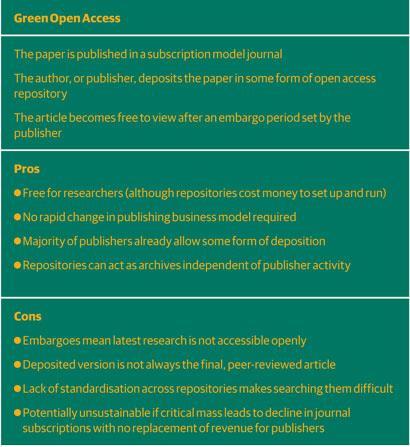Should all journal articles be free to access online?

Accumulating and disseminating knowledge for the benefit of society is fundamental to the scientific dogma. Sharing discoveries fuels constructive debate and cross-fertilisation of ideas, embodied in Isaac Newton’s famous letter to Robert Hooke: ‘If I have seen further, it is by standing on the shoulders of giants.’
But what if the giant upon whose shoulders you need to stand is locked behind a wall through which you have no access? This is how proponents of the open access movement view the traditional subscription model of scientific journal publishing.
In the subscription model, researchers - often funded with public money - publish their research findings in journals. The publishers of these journals then charge for access to the papers, and the charges are such that some people - for example the general public - who might want to read or use that research, are effectively prevented from doing so.
The alternative is to somehow make the papers available - for free - to anyone who wants to read them. This is the fundamental principle of open access.
Current political pressure on governments to be more transparent about how they spend taxpayers’ money, coupled with a growing resentment towards some journal publishers for perceived profiteering practices, has brought the debate to the fore in recent years.
But working out how to make this happen in a way that is acceptable and sustainable for publishers, researchers and the various libraries, institutions and other stakeholders is far from trivial. There are several sticking points, including concern from publishers over how to structure a viable business around open access, along with researchers worrying about where the money will come from to fund the publication of their work.
Finding the motivation
Another barrier is the impetus required to alter the status quo. The vast majority of people who need regular access to journals - primarily researchers - belong to institutions or companies with subscriptions to the journals they want to read. How much would the general public actually gain from access to complex, technically written and jargon-heavy articles?
From a researcher’s viewpoint the argument is mostly ethical, says Rob Stockman, an organic chemist from the University of Nottingham, UK. ‘In principle, the benefit is that people anywhere in the world can read your papers; you’re not excluding anyone. Science is very open - the whole ethos is to share your discoveries as widely as possible so open access fits in with that very well.’

Government funding bodies are also an important driving force behind the open access movement. In the current economic climate, being open about what their money is spent on has become more important than ever. There are also growing objections to the public paying for the research twice - once for the scientists to do the work, and then again to read the results.
This has led to mandates from some government funding bodies that all papers containing work they have funded must be open access. Funders such as the UK’s Wellcome Trust, the US National Institutes of Health (NIH) and the UK Medical Research Council led the charge, but physical sciences bodies are now starting to enforce the same rule.
As Ben Ryan, senior evaluation manager for the UK’s Engineering and Physical Sciences Research Council (EPSRC), explains: ‘The issue of open access to research is much higher up the agenda now than it was even two years ago.’
Ryan points out that in 2006, Research Councils UK (RCUK), the umbrella body for UK government funding bodies, stated that ‘ideas and knowledge derived from publicly-funded research must be made available and accessible for public use, interrogation and scrutiny, as widely, rapidly and effectively as practicable’. In September 2011, the EPSRC introduced a more specific policy statement - consistent with the RCUK policy - making it mandatory for researchers to make research it funds open access by any appropriate route.
Green for go
One straightforward way to comply with these mandates is to use repositories. Papers, published in subscription model journals, are deposited in repositories (run by research institutions or third-parties such as funding bodies) that are freely accessible to everyone online. This is called Green Open Access (see box below).
PubMed Central (PMC) is the most successful such repository. It is run by the NIH and stores predominantly biomedical research articles. The NIH requires that papers arising from its funding are deposited in PMC as soon as they are accepted, and made publically available no more than six months after publication.

David Lipman, director of the US National Center for Biotechnology Information, which houses PMC, says that over 75% of NIH-funded papers now comply with the policy. The fact that the vast majority of publishers allow researchers to deposit their work, and many even complete the process themselves automatically, has certainly helped. ‘The NIH has been monitoring compliance but not pushing too hard,’ he says, ‘so I think that, largely, the biomedical community has come on board.’
Going for gold
The biggest down side of Green Open Access is that researchers may be bound by an embargo period of up to two years before they can make the article freely accessible. The length of the embargo depends on the publisher - the RSC’s is currently 12 months.
While Ryan acknowledges that this is not perfect: ‘the EPSRC would ideally like all the research it funds to be freely available from the date of publication’, he says funding bodies do understand and are sympathetic to the complexity of the issue. RCUK is working with researchers and publishers to come up with an arrangement that is sustainable and acceptable to all parties. As part of this process, it is represented on an independent working group set up by the UK government to examine ways of expanding access to published research findings.
In most cases, Ryan says, this points towards Gold Open Access (see box below). In this model, the journal is paid a fee to publish the work, and then - once published - the article is freely available to everyone online.

This can either be done through dedicated open access journals - such as PLoS One from the US Public Library of Science (PLoS) - or in established subscription model journals operating a hybrid system where paid-for articles are freely available but others are restricted to subscribers.
The fees range from free - for journals supported by endowments such as Beilstein Journal of Organic Chemistry and the Wellcome Trust’s eLife - to £2000 per paper for some traditional journals. The RSC charges £1600 for a full paper, with discounts available for RSC members and key journal subscribers.
EPSRC grants allow researchers to apply for publications costs as part of the ‘direct costs’ of the grant, provided papers are published during the grant period. ‘We recognise that doesn’t happen for a number of papers because they aren’t published until the grant has passed its end date,’ says Ryan. ‘But there are also the “indirect costs” on grants, which are funds paid to grant-holding institutions, and publication costs are legitimate in that, and they can be used outside the grant period.’
However, Ryan admits that researchers rarely have any leverage over these funds, which are used to cover institutional overheads. He says that it is the responsibility of institutions to set aside money from their grant income to support open access publication costs.
Other funders have different approaches. Since 2005, the Wellcome Trust - a charitable foundation - has mandated that research it funds must be made open access. It has also made appropriate funds available (just over £3 million in 2010) to cover publication costs, either through block grants to institutions or on a case-by-case basis. Ryan notes that some government funding agencies follow this model: For example, the Austrian Science Fund will reimburse publication costs up to three years after a grant has ended. However, he adds that such systems involve considerable administration to prevent abuse, and are inevitably complex when dealing with collaborative papers from authors with multiple funding sources.
The publisher’s view
Publishers - including the RSC - also favour Gold Open Access, says Jim Milne, the RSC’s managing director of publishing. ‘The funding that comes with the paper supports the publication process - the manuscript handling, peer review, copy editing, typesetting and platform delivery, which means we have a business model that’s sustainable,’ he says.
Authors have had the option of paying to make their papers in the RSC’s subscription model journals open access since 2006, and other major publishers including Nature Publishing Group, Wiley-Blackwell, the American Chemical Society and Elsevier offer similar options.

But uptake at the RSC has been very low and has not increased as a proportion of the total number of papers published, says Milne. In 2011, just 36 of the RSC’s 20,419 articles (0.2%) were open access. ‘However, that could change,’ he adds, ‘and if it does we’ll be ready for it. If the community wants to support Gold Open Access, the RSC will support the community.’
The Gold Open Access route has its own issues, though, particularly over a period of transition from the subscription model, says Milne. Even if one institution, country or funding body pays to make all its output open access, it will still have to pay to read everyone else’s research that is not open access.
Publishers such as the RSC have pledged not to ‘double-dip’: they will base subscription charges only on those articles that are not open access. But with rapidly rising numbers of papers being published, this is unlikely to have much impact on subscription costs in the near term. ‘If the whole community went forward [to open access] in one step, it would have a more or less neutral effect for the RSC,’ he adds, ‘but that’s quite unlikely.’
Milne also points out that Gold Open Access shifts the financial burden of publishing further onto academia. ‘Industry publishes very little, but consumes a lot, and hence currently pays its share of money into the process,’ he says. ‘In an open access environment, academia would end up putting more money into the system and corporations would get a much cheaper ride.’
Moving forward
One factor that may start to tip the balance is that libraries with squeezed budgets are increasingly scrutinising the value for money certain journals offer. Journal subscription charges have risen significantly faster than library budgets in recent years. This is partly driven by strong growth in the numbers of articles being published, but some publishers have been accused of inflating prices and using unscrupulous sales tactics to increase profits.
While resentment of such practices will probably not lead to significant subscription cancellations, Nottingham’s Stockman believes it may prompt researchers to start voting with their feet, and looking for alternative journals in which to publish.
NIH’s Lipman, meanwhile, believes that ultimately it will be market pressures that force publishers to drive forward open access. He observes that this may already be happening with PLoS One. ‘The proportion of open access articles in PMC has increased more or less linearly,’ he says, ‘but for PLoS One the growth has been explosive.’ He notes that this has led to a spate of copycat journals.
‘The internet has changed other businesses dramatically, but in publishing it hasn’t really changed that much so far - people have simply put their content online,’ Lipman says. ‘Open access changes the business model - you make money by providing a service, rather than by having content to which you provide access. One possible side effect of that is publishers may begin to compete in terms of the service they provide authors. If that’s coupled to an author pays business model, then competition should work to improve service or reduce costs.’
Damian Pattinson, executive editor of PLoS One, agrees that the journal has been successful because it offers researchers more than simply open access. He says that it is the journal’s fundamentally different approach to deciding which papers to accept that has really captured the imagination of researchers.
Rejecting papers where the science is sound but the work is ‘unsuitable for the journal’ or ‘not significant enough’, means work can go through several rounds of peer review at different journals, each time starting with new reviewers, before finally being published, Pattinson explains. Instead, PLoS One referees are asked to judge whether the science is rigorously performed and that the experimental evidence supports the conclusions drawn. ‘It’s not so much that our peer review process is faster or any less rigorous, but that you avoid multiple iterations,’ he adds. Those subjective assessments are then dealt with after publication, by allowing the community to decide what the most important research is, and using various article-level metrics to measure it - citations, downloads views, ratings, comments and even social media metrics such as tweets and facebook likes.
Time will tell whether such alternative metrics will overtake traditional measures like the journal impact factor. But Pattinson is convinced that measuring at an article level is more meaningful for researchers than at a journal level.
Perhaps coupling the ethical argument for dissemination with these and other innovations in the service publishers provide is key to driving forward the open access movement. Or maybe it will be something completely different, as Lipman suggests: ‘The younger cohort, who are used to using the internet to communicate in much more fluid ways, may not be happy with the traditional models, and end up changing things quite dramatically. I don’t see it right now, but these things tend to hit you before you’re ready for them!’












No comments yet